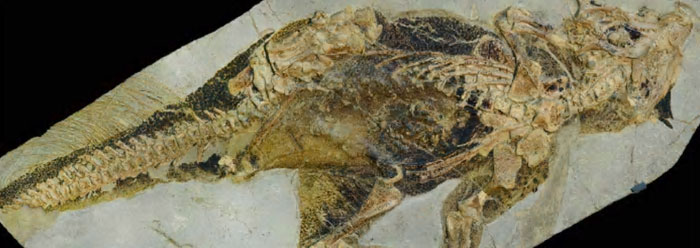The term "fossil" is typically associated with once-living things that have been turned into rock. But wood, leaves, mosses, and insects from an ancient forest in Maine were found preserved without having been mineralized. A recent study delved into the mystery of how these plant and other remains could still be so fresh.
Geologist Woodrow Thompson began investigating the "largest and best preserved accumulation of ancient wood…found in Maine" as part of a geologic mapping survey in 1976. He found pieces of wood buried in an Ice Age clay formation in a gravel pit. Local NBC News affiliate WCSH reported, "The trees encased in clay did not look that old, in fact some of the white spruce limbs still had needles on them that were green."1
Thompson said, "These pieces of wood don’t fit your notion of a fossil….This is very fresh looking wood. It looks as though you could put a match to it and it might still burn."1
At the time, he shelved the mystery in order to continue work on the Maine Geological Survey. But in 2007, hospital construction unearthed more samples from the same area. Thompson and his colleagues published these findings and an explanation for their origin in the journal Quaternary Research.2 Their article reported a carbon date for the wood of approximately 12,000 years in age.
Unsurprisingly, these numbers generally line up with the evolutionary time scheme for Ice Age deposits, since those are the only numbers accepted by mainstream peer-reviewed journals for remains associated with Ice Age events. Also unsurprisingly, the dates contrasted with other natural clock indicators, including tree ring counts and varve-counting methods that were reviewed in the technical paper.
The study authors settled on an "age" for the preserved wood of about 13,520 years. But the fact that these new dates "correct previously published radiocarbon ages" shows that all the "clocks" employed in the dating process provided different ages.2 Are any of them reliable?3 In contrast, according to biblical chronology—a dating method that relies on eyewitness accounts—Ice Age catastrophes like this one in Maine occurred on the order of 4,000 years ago.
Thompson was able to reconstruct the burial scenario that had preserved the plant products so perfectly. WCSH reported:
Sometime all those years ago, the marine clay that composed the western slope of the hill (today's Western Promenade) became destabilized, and a massive landslide—hundreds of feet wide—occured [sic]. The trees became buried in the marine clay and lay perfectly preserved for thousands of years.1
Whether those "thousands of years" are 13,500 or only 4,000 depends on the dating method used, although one wonders if the natural decay of chlorophyll molecules, which give leaves their green coloration, could have left them intact enough to still reflect green light after 13,000 years.
Regardless, these results illustrate that catastrophic conditions are required to form fossils. And both the ancient melting glaciers that loosened the earth to cause the landslide and the original earthen deposits themselves also require an explanation for their formation.
Glaciers could not have formed in this area without a hot sea surface temperature—much hotter than any slow and gradual processes could have allowed. Only hot oceans evaporate fast enough to add sufficient water to the atmosphere so that more frozen precipitation accumulated in the winter than the summer sun could melt. And how did the landslide material get piled up on the continent? The Quaternary Research article described it as containing "marine invertebrate shells."2 Somehow, sediment and clams were deposited together onto the continent.
The biblical account of the worldwide Flood offers the best explanation for these clues. First, the massive Flood washed mud and sea creatures onto the continents. Soon afterward, the continents were buoyed upward by extraordinarily powerful mountain-building forces associated with the Flood. The same Flood involved volcanic activity that heated the world’s oceans, causing the post-Flood Ice Age. After ice had built up for perhaps hundreds of years, it then began melting and some of the Flood-deposited sedimentary material slid down catastrophically to bury the poplar and white spruce trees that Thompson and his colleagues later uncovered.4
Catastrophes such as floods, landslides, and mudflows provide the most scientifically sound explanation for fossils in general, and they are the only known way to preserve organic remains. And catastrophes don’t require much time. The evidence left behind by these post-Flood catastrophes—such as this "fresh looking" wood in what is today called Maine—fits in well with the general observations taken from the Bible about earth’s ancient past.
References
- Goff, T. Ancient trees found buried in clay a Maine mystery 13,500 years in the making. WCSH 6 News. Posted on wcsh6.com June 25, 2011, accessed June 27, 2011.
- Thompson, W. B. et al. 2011. Associated terrestrial and marine fossils in the late-glacial Presumpscot Formation, southern Maine, USA, and the marine reservoir effect on radiocarbon ages. Quaternary Research. 75 (3): 552-565.
- Batten, D. Tree ring dating (dendrochronology). Creation Ministries International. Article posted on creation.com, accessed June 27, 2011.
- Vardiman, L. 1994. Out of Whose Womb Came the Ice? Acts & Facts. 23 (8).
* Mr. Thomas is Science Writer at the Institute for Creation Research.
Article posted on July 19, 2011.
























